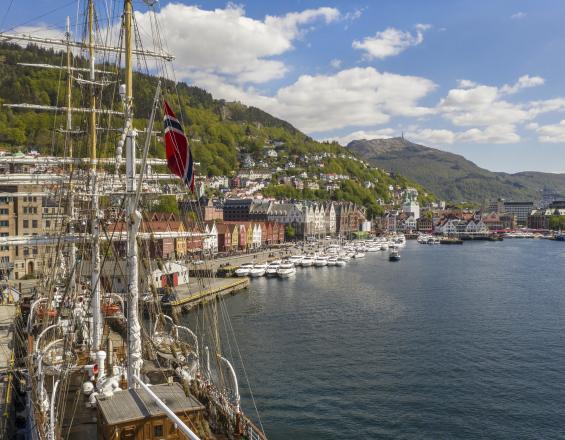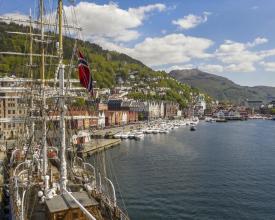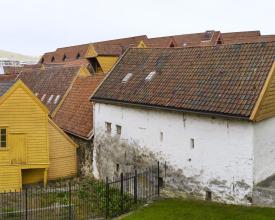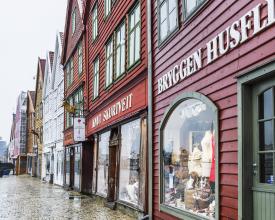
Establecimiento de una estructura compartida de gobernanza y gestión del sitio del Patrimonio Mundial de Bryggen (Noruega)

El sitio del Patrimonio Mundial de Bryggen (Noruega) se inscribió en la Lista del Patrimonio Mundial en 1979 por su característica arquitectura de madera y por ser uno de los grandes puertos comerciales más antiguos del norte de Europa. La gestión de Bryggen requiere la coordinación con varios agentes a escala nacional y local, desde organismos nacionales hasta el municipio local y grupos de residentes. A lo largo de los años, la gestión de Bryggen ha evolucionado para incluir a una serie de agentes y establecer un sistema de comunicación entre los distintos instrumentos de planificación y desarrollo. Para lograrlo, se estableció una nueva estructura de gestión que incluye a todos los actores clave y se ha elaborado un nuevo plan de gestión que ha sido adoptado/aceptado por las autoridades políticas locales.
Contexto
Défis à relever
En la gestión del Patrimonio Mundial se hace hincapié en los enfoques comunitarios y centrados en las personas, que también se incluyen en las directrices operativas y otros procesos de la Convención del Patrimonio Mundial, así como en el marco nacional noruego para la gestión del Patrimonio Mundial. Sin embargo, uno de los principales retos es que el Patrimonio Mundial aún no se ha incorporado plenamente a la legislación nacional noruega, lo que plantea algunos problemas en la participación real de las comunidades y la aplicación de enfoques centrados en las personas a nivel local como parte de la gestión del bien del Patrimonio Mundial de Bryggen.
Además, la experiencia de la gestión de Bryggen como sitio del Patrimonio Mundial desde 1979 también ha puesto de relieve la necesidad de acuerdos de gobernanza más compartidos y participativos que reflejen el panorama más amplio de actores implicados en la propiedad del Patrimonio Mundial de Bryggen.
Ubicación
Procesar
Resumen del proceso
El establecimiento de una estructura global de gestión y gobernanza para el bien del Patrimonio Mundial de Bryggen ha exigido una coordinación más amplia entre los agentes nacionales, regionales y locales. La nueva estructura de gestión local ha definido claramente las funciones y responsabilidades de sus tres actores principales -el PM, el Consejo Asesor y el coordinador del PM- y el desarrollo ulterior de las acciones de gestión ofrecerá un espacio para definir mejor las funciones y mandatos de los distintos actores y partes interesadas.
El plan de gestión ofrece una conexión entre el Consejo del Patrimonio Mundial, el Consejo Asesor y las autoridades políticas a nivel local y regional. Las partes interesadas intervienen a través de su participación en el Consejo Consultivo y en la revisión general del plan de gestión, aportando distintos tipos de contribuciones. Así pues, la aceptación política del plan de gestión permite a las partes interesadas participar en la definición del marco de gestión del patrimonio, así como en el desarrollo urbano de la zona adyacente al bien del Patrimonio Mundial.
Bloques de construcción
Estructura local de gestión del Patrimonio Mundial
En 2012, Noruega adoptó una nueva política nacional de Patrimonio Mundial para impulsar una aplicación más eficaz de la Convención del Patrimonio Mundial a nivel nacional, regional y local. Esto incluye recomendaciones para el establecimiento de estructuras locales de gestión capaces de mejorar las capacidades locales de gestión.
En 2018, una nueva estructura fue aprobada por todas las partes interesadas y reconocida a todos los niveles. Consta de:
- un Consejo del PM responsable de la protección de Bryggen de acuerdo con los requisitos del PM y el plan de gestión. Consta de 4 miembros políticos (2 del Consejo del Condado de Vestland,2 del Ayuntamiento de Bergen) nombrados por 4 años.
- un Consejo Asesor refuerza la cooperación entre las partes interesadas en Bryggen con el objetivo de proteger su VUE y otros valores patrimoniales. Está formado por 10 miembros que representan a propietarios de edificios, museos, universidades, operadores turísticos, organismos de patrimonio cultural a nivel local, regional y nacional, y asociaciones de amigos.
- Un Coordinador del Patrimonio Mundial a tiempo completo financiado por el gobierno nacional y empleado en la Agencia de Gestión del Patrimonio Cultural de la ciudad de Bergen. Es la persona de contacto del sitio del Patrimonio Mundial y responsable de la participación de las partes interesadas y de la gestión del sitio.
Factores facilitadores
Hay dos factores principales que han hecho posible esta estructura local de gestión del Patrimonio Mundial:
- La política nacional para el Patrimonio Mundial, que establece estructuras locales, y el nombramiento de un coordinador del PM;
- Un proceso largo, continuo y minucioso de participación de las partes interesadas fue la base de la creación de una estructura aceptada y reconocida formalmente por todos los agentes implicados.
Lección aprendida
El desarrollo de una nueva estructura para la gestión local de los PMH requiere la aceptación de todas las partes interesadas, y esto tiene que evolucionar y desarrollarse con el tiempo. Se trata en gran medida de un proceso de aprendizaje práctico.
No hay una única manera de hacer las cosas, sino que se trata de un proceso que evoluciona hacia la identificación de la mejor manera de organizar la gestión a nivel local. A lo largo del proceso también se pueden identificar nuevas partes interesadas a las que habría que incluir.
El objetivo es coordinar las actividades e identificar la importancia de cada parte interesada para la gestión global del Patrimonio Mundial. Sin embargo, no existe un mandato para dar instrucciones ni a las partes interesadas privadas ni a la gestión pública. Por lo tanto, se trata de un proceso continuo para definir el papel y el mandato de la estructura local de gestión del Patrimonio Mundial.
Revisión del Plan de Gestión
El Plan de Gestión es clave para el éxito de la gestión de Bryggen como sitio de Patrimonio Mundial. Proporciona una buena comprensión del VUE y otros valores patrimoniales e identifica los atributos y proporciona una visión general de los posibles desafíos para la protección del sitio.
Con el establecimiento de la nueva estructura de gestión de WH, la revisión del plan de gestión por parte del Consejo Asesor comenzó en 2018. El Coordinador del PM con 4 miembros del Consejo Asesor trabajaron estrechamente en el desarrollo del plan de gestión revisado.
Cuando fue necesario, se incluyeron contribuciones adicionales de diferentes funcionarios y especialistas, sin embargo, se hizo hincapié en mantener el proceso interno para garantizar la apropiación del plan por parte de todos los actores involucrados, asegurando que contribuirán a su implementación una vez adoptado. El plan de gestión fue adoptado por el Consejo del PM en 2020 y el plan de acción se aprobó en 2021.
Factores facilitadores
- Fue vital definir claramente cómo debía proceder la revisión y qué implicación necesitaban los consejos consultivo y del Patrimonio Mundial,
- El coordinador del Patrimonio Mundial desempeñó un papel clave en la coordinación de todos los esfuerzos y actuó como punto focal para todos los agentes implicados.
Lección aprendida
La preparación y revisión de un plan de gestión para un sitio de Patrimonio Mundial es una buena oportunidad para que los actores locales encargados de la gestión del sitio se pongan de acuerdo sobre una interpretación común del VUE y otros valores patrimoniales de Bryggen e identifiquen los atributos que transmiten estos valores.
La revisión fue clave para establecer algunos objetivos comunes de gestión y para iniciar el debate sobre la posible necesidad de desarrollar capacidades durante este proceso.
La revisión de un plan de gestión es un proceso que lleva bastante tiempo, por lo que hay que estar dispuesto a dedicarle tiempo y recursos suficientes. A menudo existen diferentes puntos de vista sobre la finalidad y el objetivo del plan de gestión. En la preparación del nuevo plan deben participar diferentes partes interesadas y el proceso de planificación de la gestión ofrece un espacio para debatir sus diferentes retos y agendas, entendiendo que puede ser difícil abarcar todas las diferencias.
Un plan de gestión es un proceso continuo y necesita mejoras constantes, tanto en su contenido como en el propio proceso.
Interacción entre los instrumentos de planificación
Noruega no incluye disposiciones específicas sobre el Patrimonio Mundial en su legislación nacional, pero todos los sitios del Patrimonio Mundial están protegidos por el marco jurídico vigente. Sin embargo, un reto clave es garantizar que el plan de gestión del Patrimonio Mundial se reconozca y aplique en todos los planes públicos de gestión y desarrollo urbano que afecten o toquen a un sitio del PM.
Tras la aprobación del Consejo de Patrimonio Mundial, el Plan de Gestión de Bryggen fue aprobado por el Ayuntamiento de Bergen y el Consejo del Condado de Vestland. Este reconocimiento establece que el plan de gestión debe ser aplicado por todas las autoridades públicas municipales y del condado en sus actuaciones de mantenimiento de infraestructuras públicas, nuevos desarrollos urbanísticos, uso de espacios públicos y en la gestión o planificación de eventos culturales. Este reconocimiento refuerza la gestión del patrimonio cultural en el municipio y el condado y su compromiso de mantener un fuerte enfoque en la protección del bien del PM de Bryggen.
El sitio del PM de Bryggen sólo abarca una pequeña zona geográfica dentro del centro de la ciudad de Bergen. Hay varios grandes proyectos urbanísticos en curso justo fuera de la propiedad del PM. El reconocimiento político del plan de gestión se ha convertido en una herramienta para la planificación urbana más allá de la propiedad del PM.
Factores facilitadores
La estructura local de gestión del Patrimonio Mundial y su plan de gestión han sido aceptados tanto por el Ayuntamiento de Bergen como por el Consejo del Condado. Esto también da la oportunidad al Consejo del Patrimonio Mundial de dar su consejo y recomendaciones al Ayuntamiento y al Consejo del Condado sobre la cuestión de la protección del VUE de Bryggen.
Lección aprendida
El hecho de que un bien del Patrimonio Mundial esté situado en el centro histórico de una ciudad significa que las decisiones de planificación urbana pueden afectar al bien y a su VUE. El reconocimiento político ha facilitado el tratamiento de la protección del VUE y de otros valores patrimoniales como parte integrante de un proceso urbanístico más amplio. Ha aumentado el conocimiento del PM, así como la importancia de implicar a todas las partes interesadas.
Esta acción pretende proporcionar un marco para una mejor y más amplia inclusión de todos los diferentes departamentos implicados en la planificación urbana y la gestión pública en la próxima revisión del plan de gestión de Bryggen.
Impactos
La intención de establecer una nueva estructura de gestión se centró en lograr una mayor participación de todas las partes interesadas en la gestión del sitio del Patrimonio Mundial de Bryggen y en implicar directamente a los políticos tanto a nivel local como regional. El establecimiento de una estructura de gestión y el plan de gestión fueron un primer paso en la puesta en marcha de un acuerdo de gobernanza más amplio para el sitio, pero necesitará más tiempo para evolucionar y seguir desarrollándose. El proceso de definir y perfeccionar estas disposiciones es un esfuerzo continuo para definir el papel y el mandato de la gestión del Patrimonio Mundial en el sitio. La preparación y revisión del plan de gestión fue una buena oportunidad para que los actores locales del Patrimonio Mundial implicados en la gestión de Bryggen cooperaran para alcanzar un entendimiento común de los valores patrimoniales del sitio y debatieran sobre cómo mantener y reforzar su Valor Universal Excepcional (VUE), ofreciendo una base común para identificar mejoras en el papel y el mandato de las estructuras y procesos de gestión locales y nacionales del Patrimonio Mundial. El respaldo político del Plan de Gestión facilita su aplicación por parte del municipio y el condado. Se ha convertido en una herramienta para reforzar una visión y una gestión holísticas del bien.
Beneficiarios
Los beneficiarios son los agentes implicados en la gestión de Bryggen, así como el municipio y el condado, ya que el Plan de Gestión goza de aceptación política a escala local y regional. Por último, Bryggen también se beneficia de estos enfoques participativos.

















